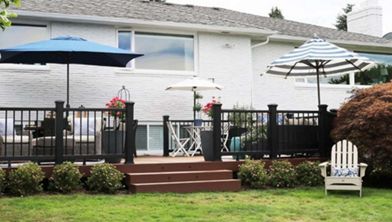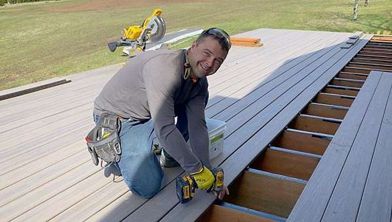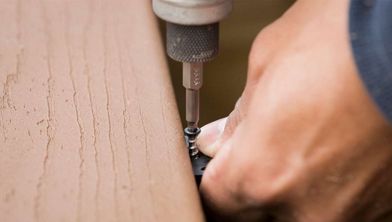How to Choose the Best Type of Joist Hanger
Learn about the different types of joist hangers to avoid costly mistakes in your deck-building process.
There are many types of joist hangers. Like many building materials, supports, and fasteners, the joist hanger types you need will depend on the job you're doing (or paying a professional to complete). Joist hangers are used throughout most framing and some building and repairs. This isn't surprising, as they're usually the best solution for creating a solid load-bearing connection or strengthening existing connections.
Joist hangers are designed for everything from strengthening and securing roof joists to attaching ledger boards to beams. This makes choosing the best type of hanger for your needs critical. Read on to ensure you are using the correct joist hanger for your deck project.
What is a Joist Hanger?
A joist hanger is a metal connector that attaches one piece of building material to another. Joist hangers come in various styles, with options for smaller lightweight jobs to framing in industrial or commercial buildings. In general, joist hangers are designed for timber-to-timber, timber-to-steel, or timber-to-masonry connections. Deck joist hangers usually affix joists to ledger boards and beams, shoring up these connections to make sure your deck can hold up to bad weather, big gatherings, and years of use.
While there are other ways to connect joists, such as 'toenailing', or driving nails in at an angle, the strongest and safest option is usually joist hangers. In fact, joist hangers are required by code when building a deck in many parts of the country.
Different Types of Joist Hangers
In order to choose the right type of joist hanger for your job, it's essential to understand your options. To decide on the hanger you need, consider:
- The materials you’re building with
- How strong connections need to be given local weather and expected loads
- Building codes
- Difficulty of installation
- If you need joist hanger sets specifically designed to support joints at an angle
There are many types of joist hangers on the market. To make the correct choice about which to use, you’ll need a primer on their pros, cons, and what they’re used for. We can’t cover all of them in this article but read on to discover six of the most common and most useful joist hangers:
Concealed Joist Hanger
As the name implies, concealed joist hangers are hidden within the joint they're strengthening. This means they provide the same robust structural support as other joist hangers while maintaining a clean look.
45-Degree Angled Joist Hangers
Designed for diagonal connections, these angled joist hangers offer stability in angled framing applications. They allow you to build decks with unique shapes or fit your deck to an awkward space while maintaining joint strength. 45-degree angled joist hangers are available angled left and angled right, so buying them as sets is essential!
Wood Joist Hangers
Not all of these hangers are for treated lumber. These hangers can be for interior use and not for treated lumber. The hangers will have different coatings to designate what type of wood they can be used on.
Also known as wood beam hangers, these joist hangers are often used to attach wood to wood. The coating of the hanger will determine what type of wood it is designed for. This type of joist hanger is often used to fix beams to joists in a deck substructure, with stainless steel or zinc-coated options best for use outdoors. They can be corner joist hangers, as they're often designed to hold lumber at a specific angle.
I-Joist Hangers
Engineered to accommodate I-joists, enhancing the joists' performance and durability. I-joists can span longer distances than other types of joists and they’re a very specific shape – specifically, they’re shaped like a serif capital ‘I’. This means joist hangers have to be specially shaped to fit them and help support the floors they’re designed to hold up.
Mini Joist Hangers
Compact designs make mini joist hangers perfect for smaller-scale projects and tight spaces. In most cases, they can be used for widths of 78mm and depths up to 100mm. These small joist hangers are useful when you’re using smaller timbers, and are often a component in deck building.
Saddle Joist Hangers
Saddle joist hangers are essentially two hangers attached to a flat plate. This allows them to cradle a joist, ensuring the two hangers are perfectly aligned and the weight is distributed evenly, reducing stress on the beam.
Fasteners for Joist Hangers
You should always follow the manufacturer's instructions when choosing a fastening system for your joist hangers. That means using the exact size and type of connector identified in the guidelines. These will usually be nails or screws made from carbon steel or stainless steel. It's also crucial to use the correct number of fasteners for each of your joist hangers. This is the only way hangers will achieve the load-bearing capacity advertised; using any other fasteners or the wrong number of fasteners means you're creating a weak and potentially dangerous connection. You should also make sure:
- Your fasteners haven't enlarged any of the premade holes in your joist hanger.
- The steel of your joist hanger hasn't been shredded, torn, warped, or damaged.
- The head of your fastener is flush with your joist.
- The nails or screws should have an appropriate coating if they are being used in an exterior application.
Where to Buy Joist Hangers
Joist hangers can be bought at hardware stores, lumber yards, or online. If you know exactly what you need, buying online is the easiest option. However, if you want advice about your building project or assistance choosing the right joist hangers it may be a better idea to go to a local store or lumber yard. Whichever option works for you, you should be able to purchase all the hardware you need to install the hangers and create strong, long-lasting connections in one place.
This content was partially or fully generated by AI and has been reviewed by our team to ensure accuracy and relevance.




































